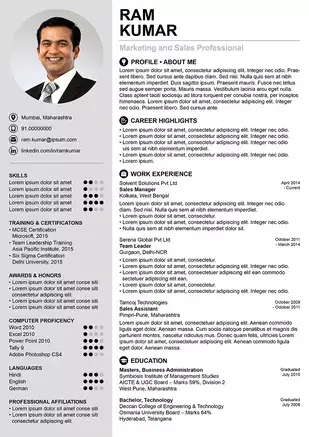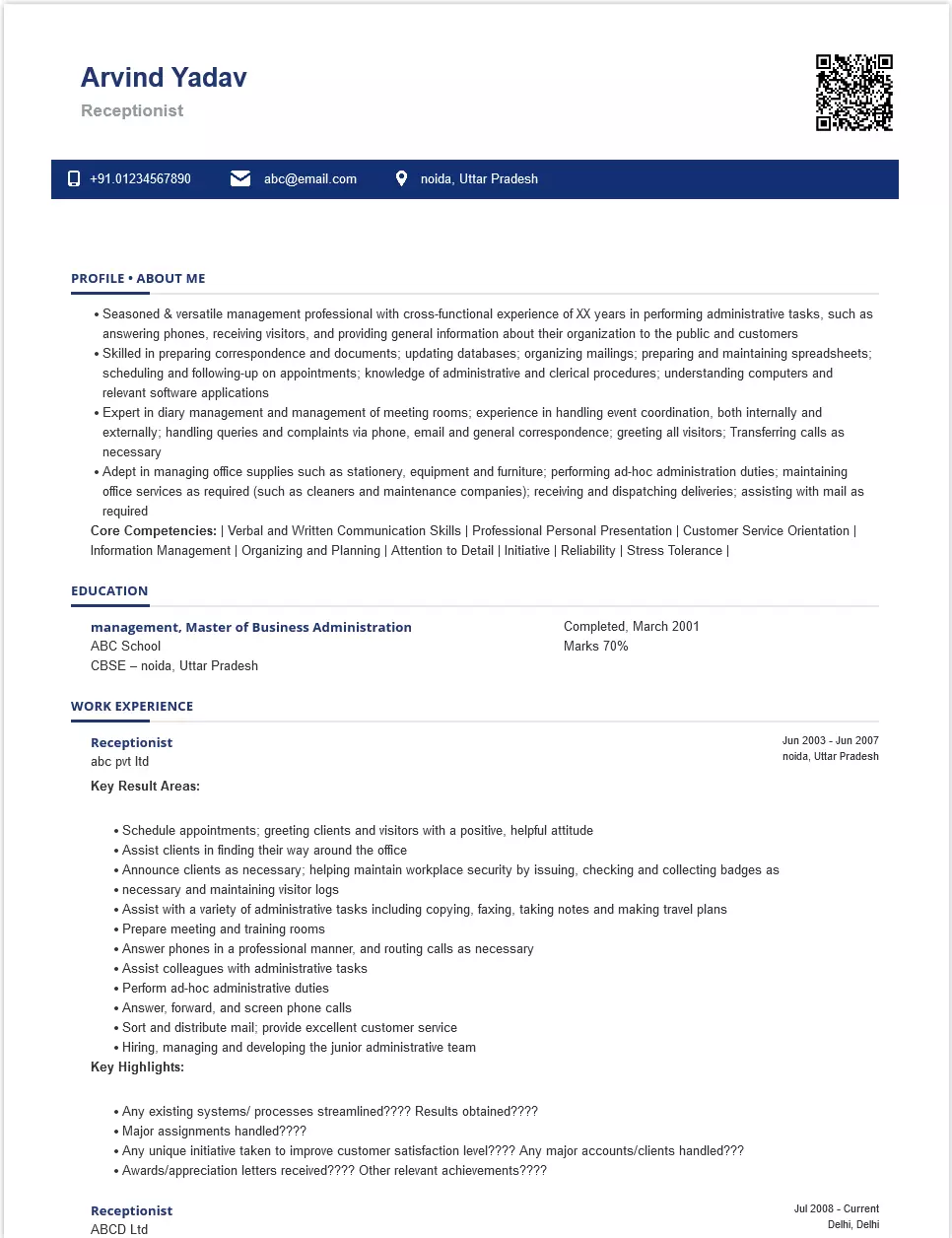- Arvind Yadav/Project Management Professional, Completed , January 2011
What's your job?
Receptionist Resume Samples and Templates for 2026
- Table of Contents
- Downloadable Sample
- Resume Tips from Experts
- Resume Text Version
- Share
Receptionist Resume Guide for India
A well-crafted Receptionist resume is essential for success in India’s corporate and hospitality sectors. Whether you’re a fresher starting your career in front office or an experienced professional seeking positions at corporate offices, hotels, hospitals, or healthcare facilities, this guide provides everything you need to create a standout resume that impresses Indian employers and passes ATS screening on portals like Naukri and LinkedIn.
This comprehensive guide includes:
- Resume format recommendations for Indian front office sector
- Key skills Indian employers look for
- Complete resume example with Indian context
- Top receptionist employers in India
- Salary insights in INR by experience level
- Certification guidance for the Indian market
- ATS optimization tips for Indian job portals
Why Your Receptionist Resume Matters in India
India’s corporate, hospitality, and healthcare sectors employ lakhs of front desk professionals. Organizations like Taj Hotels, ITC Hotels, Apollo Hospitals, TCS, Infosys, and numerous corporates actively hire receptionists. A strong resume helps you:
- Stand out from thousands of applicants on Naukri and LinkedIn
- Pass ATS screening used by hotels, hospitals, and corporates
- Showcase skills that Indian hiring managers value, including communication, visitor management, and administrative support
- Demonstrate your ability to create a professional first impression
Indian recruiters typically spend 6-10 seconds reviewing each resume initially. Your Receptionist resume must immediately communicate your front desk expertise, communication skills, and professional demeanor. With India’s service sector growing rapidly, a well-optimized resume is essential.
Receptionist Resume Format for India
Indian employers prefer clean, professional resume formats. Here’s what works best:
Recommended Format
- Length: 1-2 pages (freshers: 1 page, experienced: 2 pages max)
- Layout: Reverse chronological (most recent first)
- Font: Arial, Calibri, or Times New Roman (11-12pt)
- Sections: Contact, Summary, Skills, Experience, Education, Certifications
Resume vs Biodata
In India, use a professional resume format for corporate and hospitality receptionist positions. “Biodata” format is not suitable for modern front desk roles.
Personal Details for Indian Receptionist Resumes
Indian resumes typically include:
- Full name
- Phone number with country code (+91)
- Professional email address
- LinkedIn profile URL (optional)
- City, State (full address not required)
What to Avoid
- Decorative fonts or graphics (causes ATS issues)
- Personal information like religion, caste, or father’s name
- Salary expectations (discuss during interview)
- References (provide when requested)
Key Skills for Receptionists in India
Indian employers look for comprehensive front office expertise.
Front Desk Management
- Visitor Management: Guest registration, visitor passes, VIP handling
- Telephone Operations: EPABX handling, call routing, message taking
- Appointment Scheduling: Calendar management, meeting room bookings
- Mail/Courier: Incoming/outgoing mail, courier coordination
Administrative Support
- Document Handling: Filing, photocopying, scanning
- Office Coordination: Supplies management, vendor liaison
- Travel Assistance: Basic travel support, taxi arrangements
- Data Entry: Record maintenance, database updates
Communication Skills
- Professional Communication: Clear verbal and written communication
- Multilingual Ability: English, Hindi, and regional languages
- Customer Service: Handling queries, complaint resolution
- Interpersonal Skills: Building rapport with visitors and employees
Technology Skills
- MS Office: Word, Excel, Outlook
- Communication Systems: EPABX, intercom, video conferencing
- Software: Visitor management systems, booking tools
- Office Equipment: Printers, scanners, fax machines
Soft Skills for Indian Front Desk Roles
- Professional Appearance: Neat grooming, corporate attire
- Patience: Handling difficult visitors
- Multitasking: Managing multiple tasks simultaneously
- Punctuality: Reliability and time management
How to Present Skills
Create a dedicated skills section. Group by category (Front Desk, Communication, Technology). Highlight language skills prominently.
Receptionist Resume Example for India
Here’s a complete resume example tailored for Indian employers:
Priyanka Menon
Bangalore, Karnataka | +91-98XXX-XXXXX | priyanka.menon.reception@email.com | linkedin.com/in/priyankamenon-frontdesk
Professional Summary
Professional Front Desk Receptionist with 5+ years of experience managing reception and front office operations at corporate offices and hotels. Expertise in visitor management, EPABX operations, and administrative support with proven track record of handling 100+ visitors daily and maintaining 98% satisfaction scores. Strong communication skills in English, Hindi, and Kannada. Proficient in MS Office and visitor management systems. Seeking receptionist position at a progressive organization.
Skills
Front Desk: Visitor Management, EPABX Operations, Appointment Scheduling, Meeting Room Bookings, Mail/Courier Handling Administrative: Document Management, Office Coordination, Travel Assistance, Data Entry, Record Maintenance Communication: Professional Communication, Customer Service, Query Resolution, VIP Handling Technology: MS Office (Word, Excel, Outlook), Visitor Management Systems, Video Conferencing, Office Equipment Languages: English (Fluent), Hindi (Fluent), Kannada (Native), Tamil (Conversational)
Professional Experience
Senior Receptionist | Infosys Ltd | Bangalore | April 2021 – Present
- Manage front desk operations at corporate office with 2000+ employees
- Handle 100+ visitors daily including clients, vendors, and VIP guests
- Operate EPABX system handling 200+ calls daily with professional etiquette
- Coordinate meeting room bookings for 15 conference rooms
- Manage visitor management system ensuring security compliance
- Train and supervise 2 junior receptionists on front desk procedures
- Achieve 98% visitor satisfaction score consistently
- Support HR team with onboarding coordination for new joiners
Receptionist | The Oberoi Hotel | Bangalore | June 2019 – March 2021
- Managed front desk at 5-star luxury hotel with 200+ rooms
- Handled guest check-in/check-out, reservations, and concierge services
- Operated Opera PMS for reservation management
- Coordinated with housekeeping, F&B, and other departments
- Managed VIP guest arrivals and special requests
- Achieved “Employee of the Month” recognition twice
- Maintained guest database and preferences
Front Office Executive | Apollo Hospitals | Bangalore | July 2018 – May 2019
- Managed front desk at outpatient department
- Registered patients and scheduled appointments with doctors
- Coordinated with nursing staff and departments
- Handled insurance queries and billing assistance
- Maintained patient records with confidentiality
Key Achievements
Visitor Management Excellence | Infosys | 2022
- Implemented digital visitor management system replacing manual registers
- Trained 20+ admin staff across floors on new system
- Result: 50% faster check-in, improved security compliance
Guest Service Recognition | The Oberoi | 2020
- Received highest guest feedback scores in front office team
- Handled 5 VIP celebrity visits with zero complaints
- Result: Promoted to senior position, recognized by GM
Process Improvement | Apollo Hospitals | 2019
- Streamlined patient registration process reducing wait time
- Coordinated with IT to fix appointment scheduling issues
- Result: 30% reduction in patient waiting time
Education
Bachelor of Arts (B.A.) | Bangalore University | 2018
- First Class (68%)
- Specialization: English Literature
Higher Secondary Certificate | Karnataka Board | 2015
- 75% in Arts stream
Certifications
- Front Office Management Certificate | NIIT | 2018
- Customer Service Excellence | SkillShare | 2020
- MS Office Certification | Microsoft | 2019
- Hospitality Management Basics | Coursera | 2021
Professional Memberships
- Member, Front Office Association of India
Languages
English (Fluent) | Hindi (Fluent) | Kannada (Native) | Tamil (Conversational)
Declaration
I hereby declare that the information provided above is true to the best of my knowledge.
Priyanka Menon Bangalore, December 2024
Top Receptionist Employers in India
India’s front desk sector offers diverse opportunities. Here are the top employers:
Hospitality Industry
- Taj Hotels: Luxury hospitality
- ITC Hotels: Premium properties
- The Oberoi Group: 5-star hotels
- Marriott India: International chain
- Hyatt Hotels: Global hospitality
- Leela Palaces: Luxury hotels
Corporate Sector
- TCS: IT services
- Infosys: Technology company
- Wipro: IT and consulting
- Accenture India: Consulting
- Deloitte India: Professional services
- EY India: Consulting firm
Healthcare Sector
- Apollo Hospitals: Multi-specialty hospitals
- Fortis Healthcare: Hospital chain
- Max Healthcare: Healthcare network
- Manipal Hospitals: Hospital group
- AIIMS: Government hospitals
Banking & Finance
- HDFC Bank: Private banking
- ICICI Bank: Banking services
- Axis Bank: Financial services
- Kotak Mahindra: Banking
Real Estate & Property
- DLF: Commercial properties
- Brigade Group: Real estate
- Embassy Group: Office spaces
- WeWork India: Co-working spaces
How to Apply
- Apply through Naukri.com and LinkedIn
- Company career pages directly
- Hospitality recruitment agencies
- Walk-in interviews at hotels
- Employee referrals
Receptionist Salary in India
Receptionist careers offer stable employment with growth opportunities. Salaries vary based on experience, industry, and location.
Salary by Experience Level
| Experience | Corporate (INR) | Hospitality (INR) |
|---|---|---|
| Fresher (0-2 years) | ₹2 - ₹3.5 LPA | ₹2.5 - ₹4 LPA |
| Junior (2-4 years) | ₹3.5 - ₹5 LPA | ₹4 - ₹6 LPA |
| Mid-Level (4-6 years) | ₹5 - ₹7 LPA | ₹6 - ₹8 LPA |
| Senior (6-10 years) | ₹7 - ₹10 LPA | ₹8 - ₹12 LPA |
| Front Office Manager (10+ years) | ₹10 - ₹15 LPA | ₹12 - ₹18 LPA |
Note: 5-star hotels and MNC corporates pay higher. Tips and service charges add to hospitality earnings.
Salary by City
| City | Salary Range (Mid-Level) |
|---|---|
| Mumbai | ₹5.5 - ₹8 LPA |
| Delhi NCR | ₹5 - ₹7.5 LPA |
| Bangalore | ₹5 - ₹7 LPA |
| Chennai | ₹4 - ₹6 LPA |
| Pune | ₹4 - ₹6 LPA |
| Hyderabad | ₹4 - ₹6 LPA |
Factors Affecting Salary
- Industry: Hospitality and MNCs pay premium
- Company Size: Large organizations pay higher
- Location: Metro cities offer better packages
- Language Skills: Multiple languages add value
- Appearance/Grooming: Important factor in hospitality
Salary data based on Glassdoor India, AmbitionBox, and industry surveys.
Certifications for Receptionists in India
Professional certifications enhance your credibility for front desk roles.
Front Office Certifications
- Front Office Management Certificate: NIIT, IHM
- Hospitality Management Diploma: Various institutes
- Customer Service Certification: Online platforms
Technology Certifications
- MS Office Certification: Basic proficiency
- Typing Certification: Speed and accuracy
- Computer Applications: Basic IT skills
Communication Certifications
- Business English: Professional communication
- Personality Development: Grooming and etiquette
- Customer Service Excellence: Service skills
Hospitality-Specific
- IHM Diploma: Hotel management basics
- NCHMCT Certification: Hospitality training
- FSSAI Food Safety: For food service areas
How to List Certifications
Include relevant certifications prominently. Mention MS Office and communication certificates. Group by type.
ATS Tips for Your Receptionist Resume
Most companies use Applicant Tracking Systems (ATS) to screen resumes. Optimize yours:
For Naukri.com
- Use keywords from job descriptions (receptionist, front desk, visitor management)
- Keep formatting simple (no tables, columns, or graphics)
- Use standard section headings (Experience, Education, Skills)
- Upload in .docx or .pdf format
- Update profile every 15 days
For LinkedIn Applications
- Match resume to LinkedIn profile
- Use standard job titles (Receptionist, Front Desk Executive, Front Office Associate)
- Include language skills
- Get endorsements for customer service
General ATS Tips
- DO: Standard fonts, clear headings, bullet points
- DO: Include metrics (100+ visitors daily, 200+ calls, 98% satisfaction)
- DO: Mention specific systems used
- DON’T: Use headers/footers, text boxes, images
- DON’T: Use creative section titles
Keyword Strategy for Receptionist Roles
Common keywords from job postings:
- Receptionist, Front Desk, Front Office
- Visitor Management, EPABX, Telephone Operations
- Customer Service, Communication, Professional Etiquette
- MS Office, Appointment Scheduling, Meeting Coordination
- English, Hindi, Regional Language
- Hospitality, Corporate, Healthcare
Final Tips for Your Receptionist Resume
✅ Highlight visitor volume handled—shows experience level
✅ Quantify achievements (100+ visitors daily, 98% satisfaction, 200+ calls)
✅ Showcase language skills—multiple languages valued
✅ Demonstrate communication expertise—key for front desk roles
✅ Include technology skills—EPABX, visitor systems, MS Office
✅ Show professional appearance awareness—mention grooming standards
✅ Keep it professional—first impressions matter for receptionists
Quick Checklist
- Contact with +91 phone and professional email
- Professional summary highlighting front desk experience
- Skills organized by category (Front Desk, Communication, Technology)
- Experience showing visitor volume and achievements
- Key achievements with measurable results
- Education credentials
- Certifications (front office, MS Office, communication)
- Languages spoken prominently displayed
- ATS-friendly formatting
- Declaration statement
Ready to create your professional Receptionist resume? Use our resume builder to get started with expert-designed templates optimized for Indian job portals.
For more guidance on resume structure, check out our resume format guide with tips specifically for the Indian front office job market.
Frequently Asked Questions
What should I include in a Receptionist resume?
Start with your contact details at the top, a short professional summary, then your skills, work experience, and education/certifications. Highlight tasks that show you can greet visitors, handle phones, manage scheduling, and support office tasks — and add results or metrics wherever possible.
How do I write a strong summary for a receptionist resume?
Make it short and specific: say who you are (e.g., receptionist with X years of experience), what you're good at (communication, multitasking), and something you've achieved (like handling high visitor volumes or improving scheduling accuracy).
Which skills should I highlight?
Blend soft skills like communication, customer service, and time management with technical skills such as Microsoft Office (Word, Excel, Outlook), data entry, phone system handling, and scheduling tools. Receptionists often juggle multiple duties — showing that you're comfortable with both people and tools matters.
How should I describe my receptionist experience?
Use bullet points that start with action verbs and focus on impact. Instead of generic duty lists, explain what you accomplished — for example, "Managed multi-line phone system for 50+ calls daily" or "Scheduled appointments and organized meeting spaces efficiently."
Should I include certifications on my resume?
Yes — especially relevant ones like MS Office proficiency, typing certificates, or front office/customer service certifications. In the Indian job market, things like Front Office Management or business communication certificates can add credibility.
How do I make my resume ATS-friendly?
Keep the layout simple with standard headings (Experience, Skills, Education), stick to a readable font, avoid graphics or tables, and pull keywords straight from the job posting — things like "receptionist," "visitor management," "scheduling," and "customer service."
What if I have little or no receptionist experience?
You can still shine by highlighting transferable experience — for example, customer service roles, office assistant tasks, scheduling duties, and data entry. Focus on clear achievements and skills you've used that match the receptionist role.
How long should my resume be?
Try to keep it one page if you're early in your career. Two pages are fine if you have more experience, but make sure everything you include strengthens your case — relevance matters more than length.
Should I tailor the resume for each job?
Yes. Read the job description closely and echo the keywords and priorities they list — whether that's communication skills, visitor management, multilingual ability, or specific software tools. This helps with ATS and hits the right notes with hiring managers.
What common mistakes should I avoid?
Avoid vague duties that don't show results, overly long paragraphs, and overly creative formatting that ATS can't read. Keep language clear and real, and focus on what you did and how well you did it.
Receptionist Text-Only Resume Templates and Samples
Arvind Yadav
Phone: 01234567890
Email: abc@email.com
Address: sec-44, Noida, Noida
About Me
Receptionist
- Detail-oriented receptionist with cross-functional experience of XX years in performing administrative tasks, such as answering phones, receiving visitors, and providing general information about their organization to the public and customers
- Skilled in preparing correspondence and documents; updating databases; organizing mailings; preparing and maintaining spreadsheets; scheduling and following up on appointments; knowledge of administrative and clerical procedures; understanding computers and relevant software applications
- Expert in diary management and management of meeting rooms; experience in handling event coordination, both internally and externally; handling queries and complaints via phone, email, and general correspondence; greeting all visitors; Transferring calls as necessary
- Adept in managing office supplies such as stationery, equipment, and furniture; performing ad-hoc administration duties; maintaining office services as required (such as cleaners and maintenance companies); receiving and dispatching deliveries; assisting with mail as required
Education
Management, Master of Business Administration, Completed, March 2001
ABC School
CBSE
Noida, UP
Certifications
Work Experience
Period: July 2008 - Current
Receptionist
ABCD Ltd
- Greeted and welcomed guests as soon as they arrive at the office; directed visitors to the appropriate person & office
- Answered, screened and forwarded incoming phone calls
- brochures); provided basic and accurate information in-person and via phone/email
- Received, sorted, and distributed daily mail/deliveries
- Maintained office security by following safety procedures and controlling access via the reception desk (monitor
- logbook, issue visitor badges)
- Ordered front office supplies and keep an inventory of stock; updated calendars and scheduled meetings
- Arranged travel and accommodations, and prepare vouchers; kept updated records of office expenses and costs
- Performed other clerical receptionist duties such as filing, photocopying, transcribing, and faxing.
Period: June 2003 - June 2007
Front desk executive
Abc Pvt Ltd
- Schedule appointments; greet clients and visitors with a positive, helpful attitude.
- Helped clients navigate the office by pointing out landmarks.
- As appropriate, make announcements to clients; assist in maintaining workplace security by issuing, checking, and collecting badges.
- Help with various administrative duties, such as copying, faxing, taking notes, and making travel plans.
- Prepared meeting and training rooms and assisted colleagues with administrative tasks.
- Perform ad-hoc administrative duties and answer, forward, and screen phone calls
Skills
- Verbal and Written Communication Skills
- Professional Personal Presentation
- Customer Service Orientation
- Information Management
- Organizing and Planning
- Attention to Detail
- Initiative
- Reliability
- Stress Tolerance
Languages
Softwares
Operating System
Personal Interests
- Learning languages
- Photography
- Travel
 India's
premier resume service
India's
premier resume service





